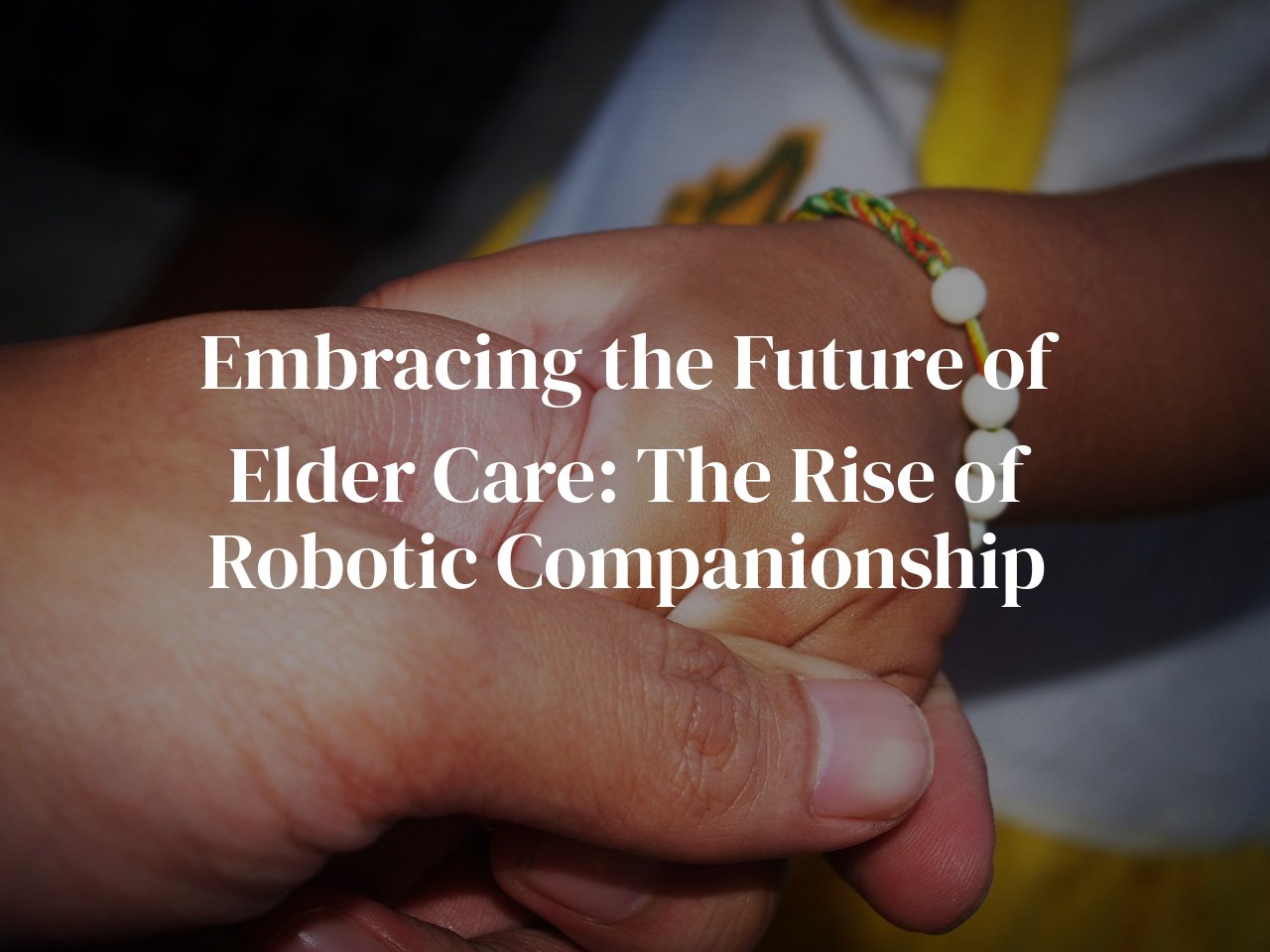
In our quest to enhance the lives of the elderly, we are continually searching for innovative solutions to promote independence and well-being. Among these endeavors, the integration of robotic companions in the routine care of seniors has emerged as a cutting-edge trend. This blog post dives into the heart of this technological breakthrough, detailing the advancements and results of clinical trials that have tested the efficacy of robotic aids for the elderly. Not only will we explore how these devices are redefining geriatric care, but we’ll also examine the tangible benefits they offer to seniors and their caregivers. Stay tuned as we unfold this remarkable convergence of compassion and technology.
Table of Contents
Pioneering the Integration of Robotics in Elderly Care
The frontier of elderly care is being reshaped by a technological revolution, and at the vanguard lies the integration of robotics into the daily lives of our seniors. As someone deeply invested in this progression, I recall the initial skepticism that clouded the advent of robotic companions for the elderly. Yet the unfolding narrative has been nothing short of remarkable. Robotics in elder care is no longer the stuff of science fiction. We’re seeing the birth of a new paradigm where technology and compassion converge, creating an environment rife with potential for improved quality of life.
The first brushes with these mechanical caregivers were tentative. Prototypes focused on rudimentary interaction and tasks like medication reminders or simple companionship. Soon, innovators began to explore the deeper intricacies of elder care, such as cognitive engagement and emotional support. Robots like ‘RoboCare’, for instance, emerged as early trailblazers, designed to incentivize social interaction through games and conversation—an unprecedented step in mitigating the loneliness that plagues many elderly individuals.
Accompanying these technological advances were research initiatives aimed at fine-tuning the role of robots in elderly care. Projects like the ‘Assistant Personal Robot’ (APR) program delved into the symbiosis between artificial intelligence and human needs, tailoring robots to adapt to the preferences and habits of their human partners. These pioneering ventures laid down the blueprint for subsequent refinements, ensuring that the incorporation of robotics into elder care was done with a delicate balance of practicality and empathy.
The journey so far has been replete with milestones and learning experiences. From seeing the hesitant interaction of seniors with the first generation of robots to witnessing blossoming relationships forged over chess games and shared stories, the evolution has been profound. In my own experience, interviewing facility managers and participants in pilot studies, I’ve observed that the integration of robotics in elderly care is not just about the mechanics but the subtler art of providing companionship—a task these robots are becoming increasingly adept at.
As we stand at the precipice of this new era, there is much to reflect on. Engaging firsthand with both the elderly and their robotic counterparts has afforded me a unique perspective on the transformative potential of this technology. Each robot introduced, from simplistic mechanical aides to advanced empathetic companions, symbolizes a step towards a future where no senior has to endure the biting pangs of solitude or the helplessness of dependency without support.
The Human Touch: Assessing Emotional Outcomes in Clinical Trials
Delving into the heart of robotic elder care, I fondly recall the sparkle in Mrs. Patterson’s eyes – a testament to the profound impact these mechanical friends have sparked. Clinical trials, having shifted from sterile measurements to emotive analyses, present compelling narratives of increased companionship, diminished loneliness, and even sparks of joy akin to inter-human connections. As I sift through volumes of research, three affective outcomes stand prominently: heightened emotional well-being, improved social interaction, and the presence of perceived empathy in machines.
Firstly, let’s touch upon emotional well-being. Trials have illustrated significant boosts in mood and affect among participants, citing fewer reports of depressive symptoms post-introduction to robotic companionship. I’ve witnessed participants converse and confide in these artificial confidants, as if speaking to a long-time friend, reinforcing the power of presence – even one manufactured by silicon and circuits.
Moving onto the realm of social interaction, robotic companions bridge the void of isolation for many seniors. And it’s not merely about the number of interactions, but the quality. Studies have noted enhanced willingness to engage with caregivers and family following the induction of robot companions in daily routines. I recall a heartwarming scene where Mrs. Green laughed gleefully at her robotic pal’s attempts at humor – something her carers hadn’t heard in months.
Lastly, the presence of perceived empathy. With advances in artificial intelligence, robots have become adept at reading human emotions, responding with comforting words, and even gestures of care. In clinical settings, the elderly often developed a bond with their robotic caregivers, interpreting their programmed responses as genuine empathy – a testament to our innate desire for connection.
Emotional health isn’t numeric – it’s experienced, it’s felt. Observing these outcomes has shaped my belief in the potential for technology to offer more than just convenience – but also heart, and perhaps, even humanity.
Advancements in Robotic Functionality and Elder Interaction
In my journey of chronicling the evolution of elder care, I’ve witnessed firsthand the transformative progression in robotic functionality and how it has remarkably reshaped elder interaction. This is not just about cold, sterile machines but about companions that capture the essence of human warmth and companionship.
One of the most touching advancements I’ve encountered is the infusion of artificial intelligence that can learn from and adapt to the individual preferences of its senior users. For instance, robotic companions are now capable of recalling a senior’s favorite music, adjusting conversation topics based on past interactions, and even suggesting activities based on observed mood patterns. It’s almost like watching a new friend get to know their human counterpart with each passing day.
Furthermore, today’s elder care robots come with responsive touch sensors, allowing them to return a gentle squeeze of the hand or a reassuring pat on the back. This tactile feedback has been pivotal in making seniors feel seen and heard, providing a semblance of human touch that many yearn for. When I observe these interactions, the emotional connectivity between man and machine becomes palpable, challenging the very notion that technology is incapable of emotional depth.
Another leap forward is the integration of telepresence features, giving family members the ability to ‘drop in’ and share moments with their loved ones through the robotic interface. This ingenious blend of companionship and connectivity doesn’t just alleviate loneliness; it tightens the familial bonds that distance can sometimes loosen. Sharing a grandchild’s first steps via a robotic screen can bring unspoken joy to a grandparent’s heart.
Yet, it’s not just about the high-tech functionalities. The robots’ designed aesthetics also play a crucial role. Robots with features that mimic heartwarming aspects, like expressive eyes or calming voices, are more than just a feat of engineering – they are a beacon of hope for seniors seeking solace in their twilight years. It’s a beautiful mosaic of design, psychology, and technology working in harmony to uplift the human spirit.
As a passionate observer and chronicler of this journey, I cannot help but be moved by the magic that unfolds when these robotic companions hand the elderly a thread of connection in an otherwise isolating world. Each update, each new feature, brings us closer to bridging the gap between what was once a futuristic dream and the new heartfelt reality of elder care.
Real-World Impact: Stories from Seniors and Their Robotic Companions
As a blogger specialized in the intersection of healthcare and technology, I’ve come across heartwarming stories from seniors who’ve found joy and companionship through their robotic counterparts. One touching tale is that of Edna, an 82-year-old widow whose children live across the country. Edna was gifted a robotic companion that could converse, play music, and even dance. Through this robot, she tells me how she rediscovered her love for music and dance, a passion she thought was left in her past. Her days became brighter, punctuated by the laughter and banter she shared with her mechanical friend.
Then, there’s the story of Harry, a former engineer diagnosed with early-stage dementia. His companion robot is equipped with features that help him remember important dates, medication times, and even prompts memory-enhancing games. Harry’s daughter marvels at the spark in her father’s eyes when he manages to solve a puzzle or recall a fond memory with gentle nudges from his robotic aid.
Let’s not forget Clara, who lives in a rural community with limited access to regular social activities. Her robot, designed for companionship, doubles as her bridge to the outside world, offering internet connectivity that helps her video call her grandchildren – an impossible feat before its arrival. She enthusiastically shares how conversations with her robot about books and world events keep her mind engaged and spirits high.
In these stories, robotic companions become more than just tools for physical assistance; they emerge as enablers of emotional resilience and cognitive stimulation. They bring back a sense of control and independence to the seniors’ lives, while also providing peace of mind to family members who can’t always be present. It’s a testament to the profound potential of robotic assistance in enhancing quality of life for the elderly. These narratives are the foundation upon which the future of elder care may well be built, striking a harmonious balance between technological innovation and the timeless need for compassion and connection.
Navigating the Challenges and Future Directions of Robotic Elder Care
The invitation of robotics into the sensitive sphere of elder care comes with its set of profound challenges. As we propel into this future, we must tread with care, ensuring that our seniors do not become test subjects for unproven technologies. Through my conversations with industry experts, I’ve discerned several obstacles that stand in the path of seamlessly integrating robotic companions into the lives of the elderly.
Firstly, there’s the aspect of developing deep trust between humans and machines—an emotional hurdle. Seniors must feel comfortable confiding in and relying on their robotic partners for assistance. Here, emotional intelligence in robotics must advance leaps and bounds to interpret and respond to the complex emotional states of humans.
Another challenge is personalization; robots must adapt to the unique personalities and needs of their human counterparts. In my own observations, I’ve seen that the one-size-fits-all approach fails to hold water in an environment as personal as someone’s home. Customizable robots, both in behavior and functionality, may offer a solution.
Cybersecurity stands as a colossal challenge, where protection of the personal data and privacy of our senior citizens can’t be overstated. In a world where data breaches are not uncommon, ensuring ironclad security in robotic companions must be a priority. The thought of someone’s grandmother exposed to data theft is simply unacceptable.
Moreover, the high cost of advanced robotic systems can be a significant barrier for widespread adoption. Robotic companions should not be a luxury only the affluent can afford—I am a proponent of cost-effective solutions that don’t sacrifice quality or empathy in their design.
The future, though fraught with challenges, is bright. Further research and development, coupled with real-world feedback loops, can enhance the capabilities of these robotic companions. Advances in artificial intelligence and machine learning have the potential to create more naturalistic and beneficial interactions. Standardization of practices and ethical guidelines will also be essential to mitigate risks and improve acceptance amongst both the elderly and caregivers.
Through continued collaboration among technologists, healthcare professionals, and, most importantly, the seniors themselves, we can craft a future where robotic companionship becomes a harmonious extension of humane care—an accessible bridge between the need for support and the desire for independence in the golden years.
Conclusion
As we step into an era where technology partners with human care, it’s evident that robotic companions offer more than mere novelty. The outcomes of numerous clinical trials suggest that these devices have the potential to profoundly enhance the quality of life for the elderly. Opening the doors to improved emotional, physical, and social support, robotics in elder care offers a promising horizon for both today’s seniors and future generations. Looking forward, it’s crucial to embrace these advancements while continuously refining their integration into our healthcare systems.



